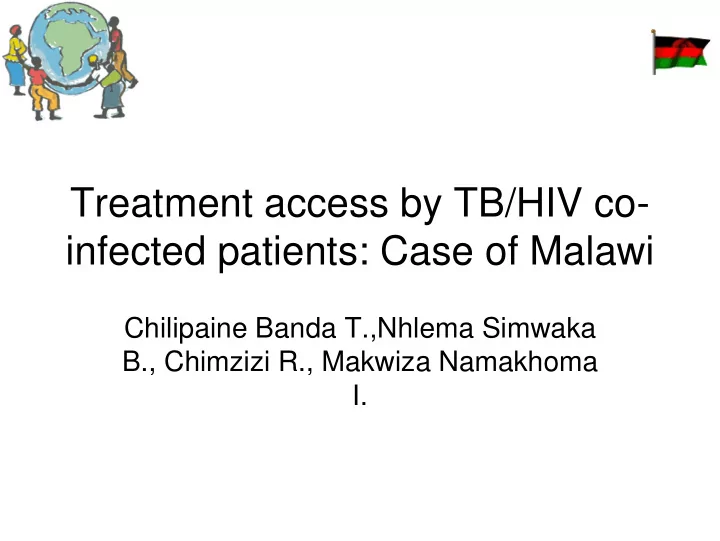

Treatment access by TB/HIV co- infected patients: Case of Malawi Chilipaine Banda T.,Nhlema Simwaka B., Chimzizi R., Makwiza Namakhoma I.
Background 1 • One of the first countries in Africa to implement the WHO “DOTS” TB treatment strategy. • Annually, Malawi notifies about 27,000 new TB cases. • Over 70% of TB patients are HIV positive also (Kwanjana et al,2001).
Background 2 • High HIV sero-prevalence rate among TB patients –One of the highest case fatality rate –In 2003, of the 7,716 notified smear positive TB patients, 18% died before completion of treatment (WHO,2005).
Background 3 • The collaborative TB/HIV activities were – To enable more TB patients to have access to HIV testing and counselling. – Be offered ART if found HIV positive (MoH, 2002b). – To conduct TB screening among HIV-positive patients – Be referred to the TB clinic to initiate TB treatment. • According to ART guidelines, all TB patients who are HIV positive qualify to be on ART.
Objective of the study • Assess the extent to which TB/HIV collaborative activities has enhanced access and adherence to ART by patients co-infected withTB and HIV
Methods 1 • Study sites: Lilongwe district at Likuni hospital and Kawale health centre. • National routine ART data registers for 2006 were used. – We assessed the proportion of TB patients enrolled on ART against the total number ART Patients ever started on ART.
Methods 2 • Qualitative design using – 13 individual in-depth interviews with TB patients on ART – 4 Focus Group Discussions with TB patients not on ART. • This method was used to understand barriers TB patients face in accessing and adhering to ART.
Methods 3 • 8 in-depth interviews with guardians of patients both on ART and TB treatment. • 6 interviews with health care workers providing TB and ART services. • 2 interviews with Key informants from the Ministry of Health.
Results 1 • By end of 2006: – 81,821 patients were ever started on ART – Of these,13,308 were started because of TB (16%). – This includes TB patients who completed treatment and those currently on treatment. – At the moment, the number of TB patients both on ART and TB is not known with precision. – Estimated that 50% of ART patients from TB clinic are also on TB treatment.
Results 2- Access and Adherence 1. Access � Patients have challenges to access both drugs due to: - Different structural arrangements of the two programmes. - The TB and ART programmes are parallel vertical programmes with limited integration in the service delivery. - Treatment offer for TB is decentralized while for ART, it is centralized.
Results 2 cont.. 2. Adherence � Patient’s challenges to adhere to both drugs due to: • Pill burden- The ART fixed daily dose of two tablets, twice in a day and the use of “DOTS” TB treatment with a minimum of 2 tablets and a maximum of 5 tablets in a day means that a TB/HIV patient has to be taking 4 to 7 tablets in a day. Increased toxicity – The use of ART and TB • drugs together causes side effects in some cases.
Results 3: Patient’s perspective 1. Costs (Direct or indirect) as a major challenge to adhere to both drugs. - Direct Costs in terms of : Transport and food costs - Indirect costs in terms of : Oppurtunity cost of waiting � Food and Transport costs - Patients reported that they incur more costs in visiting the hospital on two separate days.
Quotes 1 One male TB patient on ART had this to say: – I come to collect ARVs and TB medication on different days. This is not good for me because I incur more transport expenses.
TB/HIV collaborative activities would work better if ….. • Integration of ART and TB services. • Reduction of socio-economic burden of illness on patients and their households – Mixing TB active patients with HIV positive patients without TB , poses a challenge. – Creates more risk particularly in an era of MDR and XDR.
TB/HIV Collaborative activities would work better if…. • TB registers incoperated HIV/AIDS paremeters. - This will give the proportion of TB patients who are both on ART and TB treatment for monitoring.
END THANK YOU FOR LISTENING! Acknowledgements to : • The Liverpool tropical school of medicine and international Health • The 5 th European Congress on Tropical Medicine and International health- TB/HIV session
Recommend
More recommend